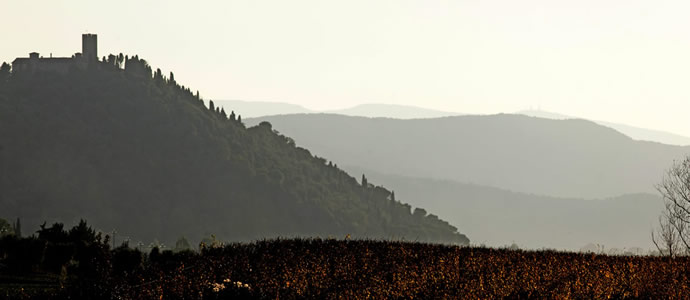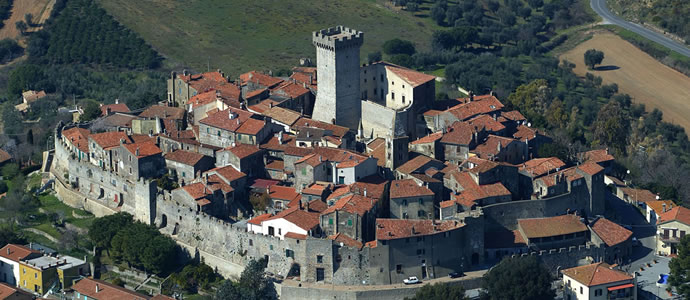Maremma
Description
The Maremma is the southernmost part of Tuscany. The variety of its territory makes it unique: the natural environment is well tended and wild at the same time, made up of great open lands, traditions and history. The Maremma will surely enchant you: its sea, beaches, islands, hills, hot springs, Roman and Etruscan archaeological sites, medieval hamlets, protected areas and delicious food will make your experience unforgettable. There are a number of charming beaches along the coastline. The Feniglia beach is one of the biggest sandy beaches, as it is about 6 kilometres long: the entire area is a natural reserve. The hill of Ansedonia and the promontory Monte Argentario are linked by this amazing sand bar. A bike path, which is accessible to pedestrians too, stretches across its entire length, shaded by centuries-old maritime pines. Along the way several information plaques show many accesses from the forest reserve to the sea. Moreover, the side which watches over the lagoon is equipped with many ornithological observatories. A nature trail and a jogging path stretch along its entire lenght. Another natural reserve is the park Parco dell’Uccellina: it stretches from Talamone, a little port town famous for historical events dated back to the period of Garibaldi, to the estuary of the river Ombrone. Here beaches and quiet inlets follow one another (Cala di Forno, Collelungo): they can be reached on foot, by walking through the scented Mediterranean maquis. It is also possible to visit the impressive ruins of San Rabano cloister. It is easy to bump into a boar, which is the main ingredient in most traditional recipes. You may also see wild horses and long-horned cattle grazing in the land. In the surroundings of Capalbio, the natural reserve of the Lake of Burano safeguards 13 kilometres of coastline. Among these beaches, there are fully equipped beach resorts which offer every comfort. The rugged promontory of Monte Argentario is scattered with rocky beaches and inlets with crystal-clear waters: some of them can be reached just by sea (it is possible to hire a boat). Porto Ercole (where Michelangelo Merisi, better known as Il Caravaggio, died on 18th August 1610) and Porto Santo Stefano are two picturesque coastal villages: together with Orbetello, they mainly bloomed during the Spanish domination period. The four fortified buildings (called forti, TN) deserve a visit: in particular Forte Stella, which is characterized by a six-pointed star shape. A trip to the islands of the Tuscan Archipelago can be ideal for the ones who want to enjoy a day bathing, snorkeling or joining guided tours. It is the greatest protected marine area in Europe and stretches from the islands Isola del Giglio, Giannutri, Montecristo, Pianosa to the Island of Elba. If you want to relax and dedicate a day to your well-being, you can not miss the worldwide famous Saturnia’s thermal baths: the sulfurous waters have a temperature of 37 degrees. They have therapeutic properties and have been well known since the Roman period. There are several natural pools of warm thermal water, which are free and open to the public; moreover, there is an exclusive wellness and spa centre.
The Maremma will make you travel back in the past. There are several well preserved archaeological sites, which date back to the Etruscan and Roman periods: they are all located in an area within 30 to 40 kilometres. The ancient urban area of Cosa (II century B.C.) rises along the coast and overlooks the promontory of Ansedonia. The ruins of an ancient Roman villa, of the city walls, of the forum and of the temple of Zeus will bring you back in ancient times. In the warm summer sunsets, the ruins of the amphitheater are used as stage for brilliant theatrical performances, whilst the perfect place to enjoy a sunrise or a concert is Ghiaccio Forte, a former Etruscan urban area. Do not miss the archaeological site of Sovana, lost among the hills: about one hundred majestic graves have been hollowed out the rocks. A suggestive tour awaits you: a curvy street network dated back to Etruscan times links several villages and even a necropolis. It involves a wide area characterized by the presence of tuff: here you can find Sorano and Pitigliano. The latter is renowned because of the nickname “little Jerusalem”: in fact, a well-integrated Jewish community had here a synagogue and left also several cultural features in the cooking. Castles and city walls are the main features of medieval hamlets such as Manciano, Magliano in Toscana and Capalbio, where you will enjoy pleasant walkings among its maze of cobbled alleys. Some artists chose this area for permanent exhibitions of their masterpieces: that is to say, Niki de Saint Phalle, eclectic artist who passed away in 2002. Her pieces of work have been scattered on the hill of Garavicchio, nearby Capalbio, within an area of two hectares: majestic colourful sculptures blend with the lush Mediterranean maquis, which surrounds them as though to protect them. This amazing park is opened to the public and counts thousands of visitors every year, who come from every part of Europe. The Maremma is especially famous for food and wines: the art of cooking is simple, genuine and rich in traditional ingredients, which are tightly tied to country life. Herbs, game, meat and local products are the main ingredients. Typical appetizers are bruschette (toasted bread seasoned with oil, TN) and croutons with chicken liver paté, whilst two of the most well-known soups are panzanella (salad of soaked bread and tomato, TN) and acquacotta (depending on the version, it can include bread with vegetables, eggs, cheeses, mushrooms, wild herbs, TN). Tortelli (type of ravioli, TN) and pappardelle (wide strips of pasta, TN) are typical main courses, whilst boar meat and the bistecca alla buttera (type of steak, TN) are second courses. Cheeses are great, especially pecorino (Italian sheep cheese, TN), as well as oily fish or fruit and vegetables. All is obviously flavoured with extra virgin olive oil and comes with excellent local wines (Morellino di Scansano, Vermentino, Ansonica Costa dell’Argentario DOC, Pitigliano DOC, etc.). In addition to restaurants (some of them are starred too), it is possible to taste these delicious dishes at local rural festivals, which are mainly concentrated in the period that goes from May to September. Several commercial farms produce organic products and have outlets where is possible to purchase their delicacies. This is only a brief description of the Maremma: you can experience its actual beauty just coming here.


















